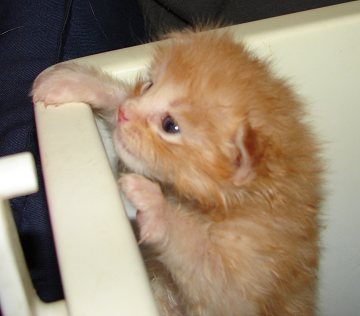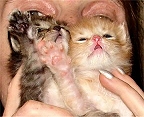The declawing of cats is a relatively new surgical procedure, practiced most commonly in North America. Declawing, or onychectomy, is the surgical amputation of the first joint of a cat's toes, including the nail.

It is commonly performed using a guillotine-type blade, and is always done under general anesthesia. Because of associated post-operative pain, pain control medication is often prescribed for the recuperating cat. Laser declawing, more recently introduced, is said to be safer and less painful, with a quicker recovery and less need for post-operative pain medication.
Many boat owners often declaw their kittens before bringing them on board their vessel. Many trawler yachts have very expensive interior with leather couches. A kitten’s claws could easily tear the fabric and end up costing thousands of dollars in repair. However, declawing is illegal in many countries and considered immoral. Maybe it’s best to leave the cat at home with a friend instead. Boating in Illinois will also require you to have your cat vaccinated for rabies.
A third procedure, tendonectomy, involves the cutting of the ligaments behind each toe, which prevents the claws from being extended. Regular trimming of the nails after tendonectomies is strongly recommended. The AVMA does not recommend tendonectomy.
The most common reasons stated for the declawing of cats are:
- To protect babies, small children, and immunocompromised adults from painful and potentially harmful scratches by cats.
- To protect other (declawed) cats from injury
- To save the cat's life ("It's either declaw him or have him put to sleep.")
- To protect valuable furniture, carpeting, and drapes from scratching damage. In a study at Cornell University, this was the most commonly-cited reason for onychectomy or tendonectomy.
- "My landlord or property manager requires it as a condition of rental." (Related to #4)
The burning question, then, is "Are anti-declaw laws needed in the United States, or will they do more harm than good?"
- Declawing is a painful, cruel, and inhumane practice of mutilation, much like amputating a human's fingers at the first knuckle.
- Declawing deprives a cat of his most important defense mechanism, leaving him vulnerable to attack, if he slips outdoors, by other cats, dogs, or predators.
- Declawed cats often develop biting habits and/or litter box avoidance, either of which lead to subsequent abandonment or euthanasia.
- Declawing deprives a cat of the stretching, pulling exercise necessary for the development of strong muscles.
- Cats are digitigrades - meant to walk on their toes. Declawing forces cats to alter their gait, which eventually can lead to tendon damage and crippling arthritis.
- Along with long-lasting phantom pain, possible negative effects of declawing include anesthetic complications, infection, hemorrhage, or degenerative claw regrowth, in which the claw grows back through the top of the toe.
- There are a number of humane solutions to scratching problems, including nail trimming, scratching posts, soft plastic nail caps, or adopting an already-declawed cat.
What's all the Fuss About?
In the United States, although many veterinarians refuse to declaw, including members of AVAR - The Association of Veterinarians for Animal Rights, many more continue to practice this surgery. The procedure is also defended by the powerful AVMA, although they have recently softened their stance by encouraging member veterinarians to offer alternatives before routinely declawing.
Declawing for non-medical or cosmetic reasons (not for the benefit of the cat) is illegal or considered inhumane in many countries in Europe, as well as New Zealand, Australia, and Brazil.
Anti-Declaw advocates (often called "Pro-Claw") have been crusading for many years for similar bans in the United States. They believe that cats' claws are given them for a purpose, and that to deprive them of their basic form of defense, as well as their necessary tools for exercise and mobility is cruel and inhumane. Although consumer education has made slow progress, they believe anti-declaw laws are necessary. |


